
|
The Shipbuilding market in 2002
|
General trends
Orders
Prices
Analysis by
country
- Asia
- Europe
- U.S.A.
Prospects
|
The year 2002 was marked by:
-
A large drop in the volume of orders
in the first half, giving the impression that the world orderbook was going to be
reduced significantly for the first time since 1993. An important recovery takes
place however during the second half and more particularly in the fourth quarter,
notably in Japan but also in Korea, to such an extent that the world orderbook ended
the year against all expectations on an increase over 2001 with more than 75 million
tons.
-
Korea confirms its place as the
leading shipbuilding country with an orderbook of about 31 million gt, followed by
Japan with nearly 25 million gt. Shipyard mergers take place in these two countries.
Chinese shipbuilding is still on a rising trend with a total of 9.1 million gt on
order reached at the end of 2002. Yards continue to expand with the opening of new
docks despite a global overcapacity in the market. European shipbuilding is
struggling to keep up with a modest 6.24 million gt on order against more than 8
million gt at the beginning of the 90's. The number of orders in sectors where it
is traditionally strong (ro-ros ships, ferries, cruise ships) remains weak and it is
neither taking advantage of the revived demand in chemical carriers, which
substantially benefits to Japan, nor of the sustained level of orders for LNG
carriers. Lays off and closures are being announced and some shipyards go bankrupt.
-
Newbuilding prices continue to drop in
the first half of the year up until the autumn. These reductions (up to 15 % when
compared to 2001) are not evenly spread and depend on the type and size of ship as
well as the level of competitiveness between the shipyards. It is very noticeable
whenever demand is weak (containerships and large-size tankers) and less so for bulk
carriers. At the beginning of the autumn, prices for these big ships start to
increase with the recovery in demand.
-
The sinking of the 'Prestige', a
26 years old single-hulled tanker which was carrying 77,000 tons of heavy fuel oil,
created a new dramatic oil spill, the third in less than four years in European
waters, after those of the 'Erika' (December 1999) and the 'Baltic Carrier'
(April 2001). Following the initial declarations of European politicians calling for
a tightening of regulation, numerous owners rush at shipyards to negotiate early
deliveries. These collective requests induce price increases in the order of 5 to 10
% compared to the lowest levels of the year.
|
| Trends |
|
|
With a world GNP increase around 2.8 %, the year
2002 remained a year of little economic growth. It is nonetheless slightly better than 2001,
which had a GNP rise of 2.2 %, one of the lowest in the last ten years.

World trade growth has expanded in 2002 by
nearly 3 % whereas in 2001 it had been flat.
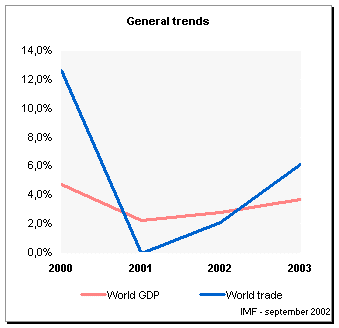
Freight rates in the three principal mainstays
of the shipping market, oil, dry bulk, and containers, which had dropped considerably in 2001,
stabilise at the start of the summer and go back up as from September 2002.
|
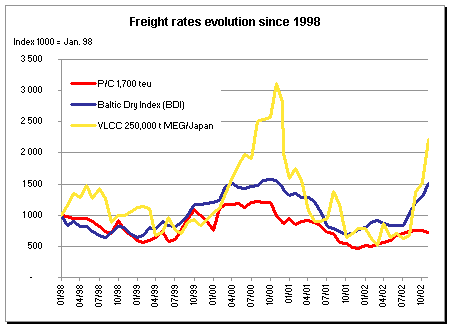
|
|
Nonetheless, the economic climate, weak freight
rates, a hazy visibility and international tensions have a combined effect and help deter
owners from the shipbuilding market during the first half of the year up until the autumn.
Low shipbuilding prices no longer seem to be sufficient to incite potential buyers. Shipyards,
whose orderbooks go through up until 2004 or even beyond, are not convinced either they should
lower their prices in order to stimulate this new demand, which would allow them to balance
their orderbooks and to reach their commercial objectives set at the beginning of the year.
Such is the case that the volume of new orders shrinks to the point that in September the world
orderbook falls below the 70 million tons mark.
|
| Orders |
|
|
This drop in the volume of orders during the
first three quarters affects principally Europe and China. Japan which is largely specialised
in the building of dry bulk carriers, is able to profit from the new interest in this sector
linked to renewal needs, given the very low level of Capesize and Panamax orders. Japan notches
up more new orders than Korea, which is more focused on building containerships and tankers.

IIn the autumn, the increase in freight rates
linked to shipbuilding prices at historic lows helps provoke a very strong demand, to such an
extent that the world orderbook finished the year at a level higher to that of 2001.
In 2002, we enter into a new cycle for bulk carriers with a very strong demand for Capesize (50
units ordered which is the most in the decade) and Panamax (no less than 75 units ordered
whereas the orderbook for this type of ship in July 2002 had fallen to 49 units). But 2002 is
also marked by a strong demand for Aframax tankers (44 units ordered).
|
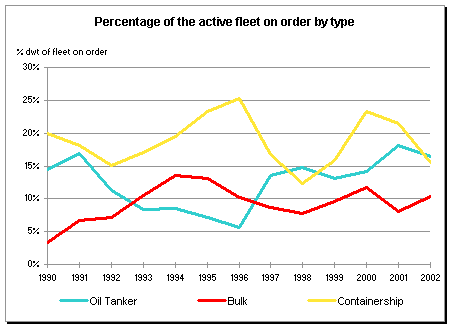
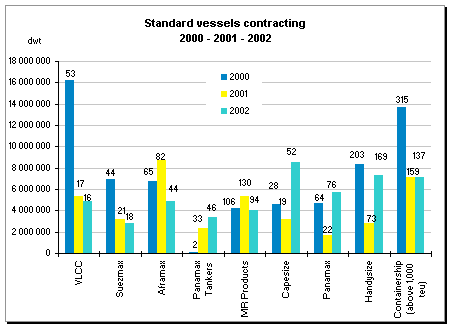
|
|
Within specialised tonnage, there is a strong
interest for chemical tankers (54 stainless steel units were ordered), after two years of weak
demand. Orders for ferries and ro-ros are limited and correspond to needs for renewing. Car
carrier orders remain steady but important renewal programmes are launched by Japanese
operators NYK, Mitsui and K Line.
There is little interest for LPG carriers : only 7 new contracts are sealed exclusively with
Japanese and Korean yards. Freight rates in this sector have never been so low and the number
of idle ships weighs heavily on the market. Ordering activity for LNG carriers has remained
healthy with 16 new contracts concluded, which is the third best figure for the decade.
Cruise ship operators are sitting on the fence : only 3 cruise ships are ordered in 2002, which
is far from the 25 contracts of 1999. New investments are hoped for in 2003.
|
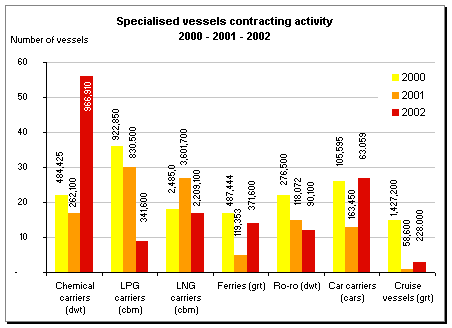
|
| Prices |
|
|
As previously indicated, a significant drop in
prices was experienced in 2002. Ships least in demand and being normally ordered in series like
large containerships, gave rise to a fierce competition between shipyards resulting in
important rebates (-15 %) ; the same applies to VLCC (-10 %) which still carry a considerable
attraction for shipyards.
It seems that a floor price was reached at the beginning of the autumn. Shipyards revises their
prices upwards due to the strong recovery in demand, brought about by improved freight rates
but also by the anticipation of tighter regulation following the 'Prestige' disaster
(November 2002). In practice, the first declarations by politicians from countries affected by
the pollution, calling for an accelerated phasing-out of single-hull tankers or to forbid
single-hull tankers to carry heavy fuel oil in European waters, was enough to incite some
tanker owners to negotiate with builders for new tonnage, leading to price increases at the end
of the year.
This price hike could well carry through into 2003 in the light of the desire by authorities to
tighten existing controls and to put them into immediate effect. This will depend equally on
the recovery of the economic growth, which is continually getting postponed.
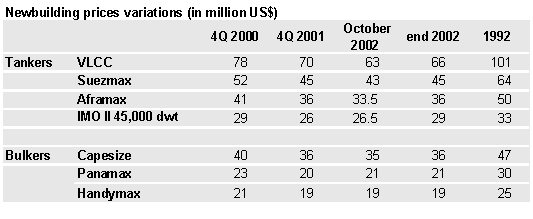
|
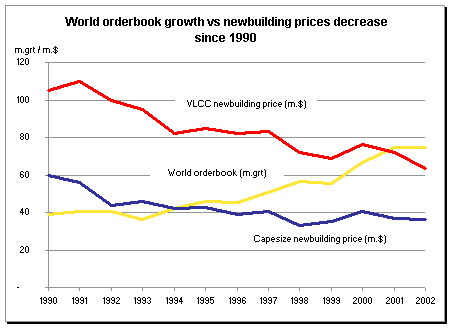
|
Shipping and Shipbuilding Markets in 2002
I N D E X
|